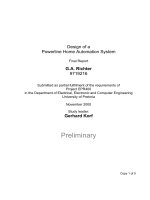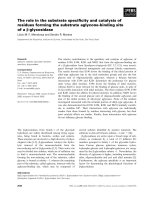Design of a Video Game docx
Bạn đang xem bản rút gọn của tài liệu. Xem và tải ngay bản đầy đủ của tài liệu tại đây (333.71 KB, 10 trang )
Tallinn University of Technology
Dept. of Computer Engineering
Chair of Digital Systems Design
Design of a Video Game
Project in „IAY0070 HW/SW Co-design”
Anti Sullin
020633 IASM-21
04.2006
Project supervisor: Kalle Tammemäe
Tallinn 2006
1. Assignment
The task of the lab is to implement a classic video game using Spartan3 FPGA
on a Xess XSA-3S1000 board. Input device for the game is a PS/2 keyboard and
output device is a VGA monitor.
2. Solution planning – the gaming platform
Memory subsystem
XSA-3S1000 board has SDRAM memory. It is clocked as the FPGA on 100MHz.
For the project, a memory controller from Xess inc is used. The controller has a
4-level pipeline. The memory is read by VGA generator, inbetween there is a 8-
word FIFO buffer. Under these constraints, the memory has to be read at least
one word per pixel drawn. When not taking into account the SDRAM refreshes
and row, bank changing overhead, then with 640x480, 60Hz VGA (25MHz dot
clock) the memory usage is about 25% and there is enough time for writing next
frame as well. As the memory row is changed, the pipeline has to be flushed and
so we lose 4 clock cycles. Thus it is important to write the memory only when the
read FIFO is full.
The video memory is composed of two layers. The data of both layers has to be
interleaved in video memory, otherwise we have to change memory row twice
per pixel and we would not meet the timing restrictions.
A two-port unit is used to interface the memory to VGA generator and
microcontroller code at once. This multiplexes the access from both channels.
The microcontroller has always lower priority to avoid starvation in VGA
generator.
Interfacing memory and PicoBlaze microcontroller
To interface memory subsystem and PicoBlaze, a memory interface is
implemented. The module is on the microcontroller bus and uses 6 output ports
and 3 input ports for communication.
address
name 7 6 5 4 3 2 1 0
000 ADDR0
A7 A6 A5 A4 A3 A2 A1 A0
001 ADDR1
A15 A14 A13 A12 A11 A10 A9 A8
010 ADDR2
A23 A22 A21 A20 A19 A18 A17 A16
100 DATA0
D7 D6 D5 D4 D3 D2 D1 D0
101 DATA1
D15 D14 D13 D12 D11 D10 D9 D8
111 CMD WR RD
Table 1 – Output port map
address
name 7 6 5 4 3 2 1 0
100 DATA0
D7 D6 D5 D4 D3 D2 D1 D0
101 DATA1
D15 D14 D13 D12 D11 D10 D9 D8
111 Status WRX RDX RDD
Table 2 – Input port map
Bit definitions:
A0-A23: Memory word address
D0-D15: Memory word
WR: Write command
RD: Read command
WRX: Write operation pending flag (set with write operation command, cleared
with earlyOpBegun signal from SDRAM)
RDX: Read operation pending flag
RDD: Read operation done flag, data in register ready (reset when ADDR0,
ADDR1 or ADDR2 is written).
Graphics subsystem
The graphics subsystem is implemented with two layer support. This way, a
background image can be loaded on one layer and the game itself can be drawn
on it without any difficult and computing-intensive operations.
The graphics subsystem is based on the VGA generator demo by Xess that uses
LPT for image uploading. The VGA generator is running by default at 800x600,
60Hz. This is lowered to 640x480, 60Hz to lower the dot clock to 25Hz. This is
important as twice the memory bandwidth is needed for two layers.
The graphics subsystem design is shown on drawing 1. The brightness of every
pixel component (R, G, B) is multiplied by a coefficient called alpha that
describes the opacity of that layer. The results of both layers are added. The
result is or’ed with the carry bit to allow saturation of the color component if sum
of both parts is higher than the maximum value.
Additionally, a opaque color can be defined on the top layer to allow transparent
areas on the top image. For that, the alpha coefficients are switched by
multiplexers. The multiplexers are controller by a comparator, that verifies if the
top layer color is equal to the opaque color.
Figure 1 – The graphics subsystem
As the BMP image format is very close to raw image data and it is relatively easy
to create with any graphics editing software, the image data is read from the
BMP format. For that, the start address has to be increased to skip the BMP
header. The BMP image has to be crafted with the right color map so that the
eight bits of the color table index correspond to the eight output bits of the VGA
generator.
To create a image in the required format, photo editing software Jasc Paint Shop
Pro is used. It is capable of converting an image to a given color map. This is
done with dithering to compensate the low number of actual colors available. The
image is more dotted but the colors are much better and there are no large areas
of the same color with very disturbing edges. After the conversion, the image has
to be rotated upside down as BMP format is written backwards. The color table is
stored in the BMP format as well but is not read in this given application.
The two-layer system works in one of two modes. If the color on the second
layer is not equal to the pre-defined opaque color, the first layer is displayed with
opacity alpha1a and the second layer with opacity alpha2a. If the color on the
second layer is equal to the opaque color, the first layer is displayed with opacity
alpha1b and the second layer is not displayed.
Alpha1a, 1b, 2a are 4-bit variables, which value 0b1000 means opacity 100%
and 0b0000 is 0%.
Test images
Settings used on test images:
OpaqueColor=”11111111” (white)
Alpha1a=”0101” (on non-opaque spot, the opacity of first layer is 62,5%)
Alpha1a
Alpha2a
Alpha1b
X
Opaq col
0
X
+ 1
=
3
3
4
4
Alpha1b=”1000” (On opaque spot, the first layer is totally visible)
Alpha2a=”0011” (on non-opaque spot, the opacity of the second layer is 37,5%)
Figure 2 – First test image
Figure 3 – Second test image
Figure 4 – Result of both images stacked
Keyboard PS/2 interface
An PS/2 keyboard interface written for “Advanced Digital Design I” course is
used. It keeps track of the state of four keys:
• Up arrow (E0 72)
• Down arrow (E0 75)
• Left arrow (E0 6B)
• Right arrow (E0 74)
PicoBlaze Interface
Only the four LSB address bits are used on the PicoBlaze port.
Port_ID(3) = 0: memory interface
Port_ID(3) = 1: VGA and PS/2 interface
Address R W
0000 - ADDR0
0001 - ADDR1
0010 - ADDR2
0100 DATA0 DATA0
0101 DATA1 DATA1
0111 STATUS COMMAND
1000 - OPAQUECOLOR
1001 - ALPHA1A
1010 ALPHA1B
1011 ALPHA2A
1100 KEYBOARD -
Table 3 - PicoBlaze I/O ports
In addition to the I/O ports, an interrupt is used. The interrupt synchronizes the
game with VGA vertical synchronization At the end of every frame, an interrupt is
given; later an interrupt acknowledge signal is returned.
3. Implementation
Hardware
A board with 3S1000 FPGA is used (XSA-3S Board, V1.0, ©2004). The custom
hardware is written in VHDL according to the given specification. For
implementation, testing and synthesizing, Xilinx ISE WebPACK’i, V8.1i is used.
Software – the snake game
A classic snake game demo is implemented on this platform. The two-layer
graphics subsystem first layer holds the background image and the second layer
the game itself. 0xFF is selected as the opaque color, the snake and the game
field is drawn with the color 0x00 (black).
At the start, the opacity of both layers is set to zero, thus clearing the screen.
After that, the second layer is overwritten with 0xFF and the borders of the game
field are drawn. Now the opacity of the first layer is increased step-by-step to its
maximal value, creating a fade effect. Then the game field is faded to 37.5%.
The game is synchronized with 60Hz VGA vertical synchronization signal. To set
the speed of the game, a number of interrupts are ignored before one is serviced.
Keyboard is read on every interrupt to find a keypress as soon as possible.
The snake head is positioned with its x and coordinates. The screen is divided
into 4x4 pixel blocks, where a 3x3 pixel cube forms one part of the snakes body.
The position of the block in video memory is calculated as:
Addr = base + (640 * 4 * y) + (4 * x) , which is transformed to:
Addr = base + y<<9 + y<<11 + x<<2.
A circular buffer is used to keep track of the snakes tail. For this, 65536 memory
words are used in SDRAM (addresses 0x100000 – 0x10FFFF). Every 16-bit
memory word holds an 8-bit x and an 8-bit y coordinate. Two 8-bit registers are
used for pointers of the circular buffer.
Figure 5 - Game screen
One more register is used to hold number of pieces the snake has to grow. This
is set to a given number at the beginning and decremented if it is non-zero. If this
register is zero, the tail of the snake is removed. Later, this register could be
used to easily add some kind of game functionality.
4. Difficulties
A number of difficulties had to be overcome for this project:
• The SDRAM memory pipeline needs to be flushed to change the memory
row. The memory row has to be changed quite actively on normal
operation. The first experiment did not have the memory areas of the both
layers interleaved and so it did not meet the timing requirements. Still, the
non-displayable periods of the VGA interface sufficed to show a quarter of
the image correctly and this was confusing.
• The SDRAM and PicoBlaze interface was quite timing-critical and it is
easy to get signal race on so high frequencies. Some designs, for
example, worked every other VHDL synthesis, even there were no
changes in these units at all.
• For some reason, the XSLOAD is not capable of loading a regular binary
file into SDRAM. Thus a converted had to be implemented to convert
binary files into XES HEX files.
5. Conclusion
The design of a video game was quite challenging process. It demanded
knowledge from many different fields – discrete mathematics, Boolean logic,
arithmetics, digital hardware, different programming languages etc. The work
was quite time-consuming, it was done on a couple of weeks on evenings and
some weekends as well. Later, after getting everything to work, I value the
experience gained and I feel that this kind of creative work and the independent
problem solving skills are very important.









